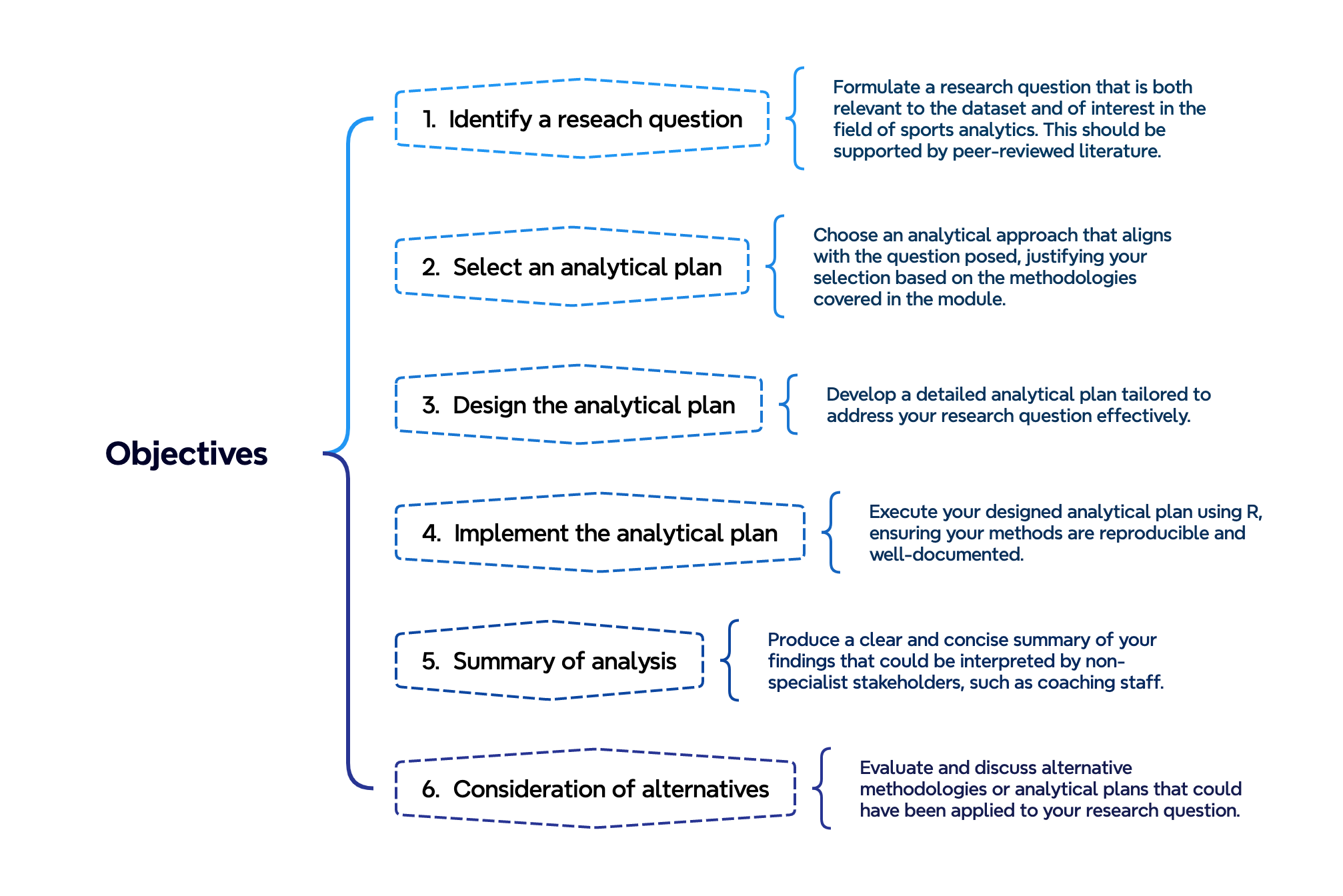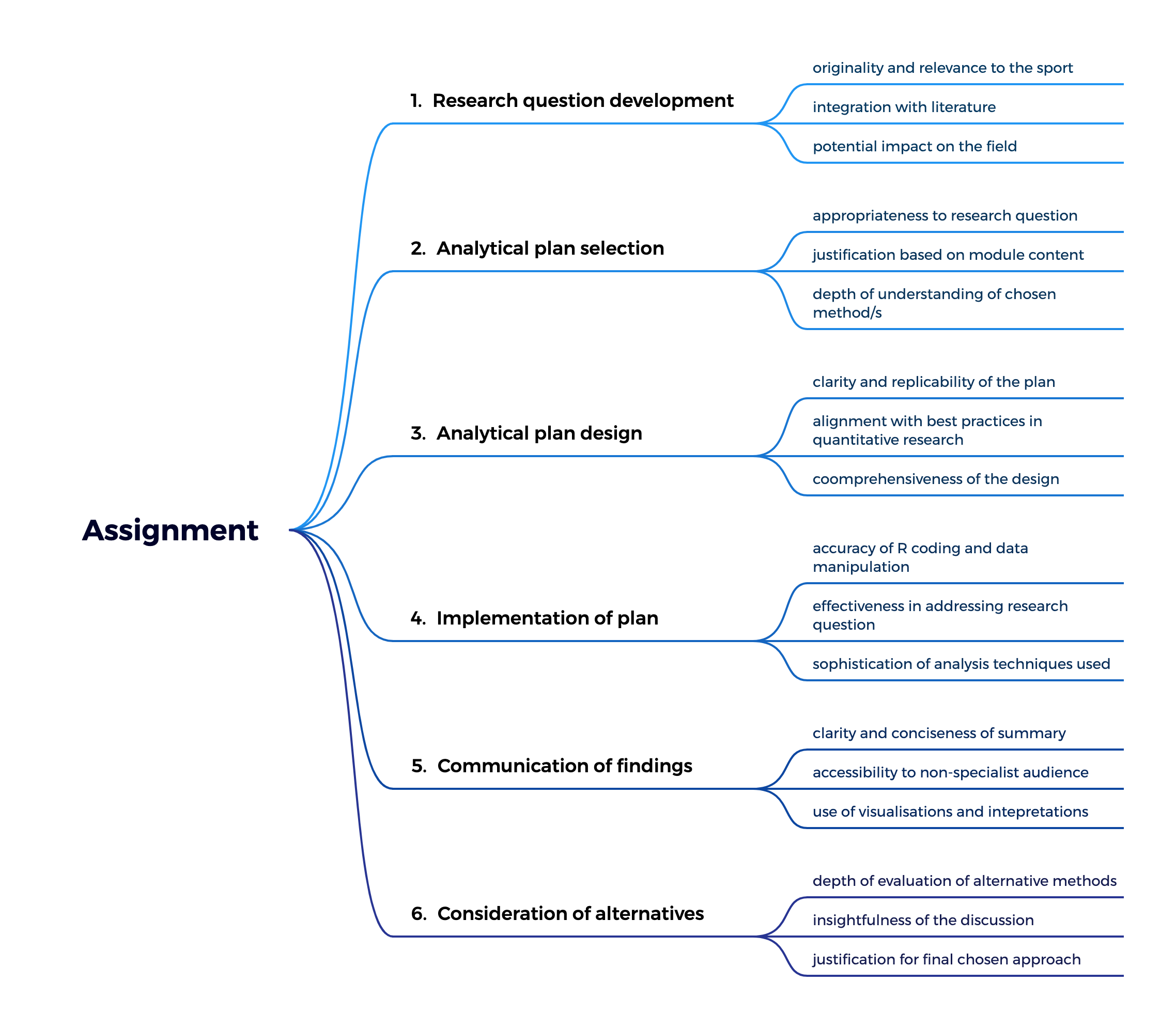3 Assessment
3.1 Introduction
Throughout the module, you’ll develop skills in various analytical techniques including multivariate and cluster analysis, path analysis, time series analysis, and machine learning, all within the R programming environment. You’ll also develop a broader understanding of the research process, including sharing the findings of research.
The assessment assignment, which comes at the end of the module, gives you an opportunity to showcase your proficiency in these areas by conducting a simulated real-world analysis that could influence decision-making in a professional sports setting.
The essence of the assignment lies in your ability to craft a meaningful research question that is rooted in the complexities and nuances of sport data. It’s not just about ‘crunching numbers’; it’s about creating a narrative that reflects the realities of performance, strategy, and management in sport.
Your research question should come from a place of curiosity and innovation, aiming to fill a gap in the field or sport and backed by peer-reviewed literature. It should have potential implications that extend beyond the dataset.
The assignment involves not just just analysing data, but also communicating findings in a manner that is comprehensible to a diverse audience, including those without a statistical background.
This dual focus on analysis and communication is critical, as the ultimate goal is to provide insights that are actionable and beneficial for coaching staff and other stakeholders.
This assignment will therefore test both your technical competency and your ability to convey complex information succinctly and effectively.
3.2 Briefing
You will conduct a comprehensive analysis of a dataset obtained from a professional sports context. More detail on the nature of the dataset will be provided later in the module.
Your analysis should demonstrate a strong understanding of the quantitative research methods covered in the module, but also demonstrate an awareness of other concepts and ideas introduced within the module, and an understanding of the related literature.
3.3 Assessment objectives
The assignment comprises six elements or tasks.

3.4 Output
When those six tasks are completed, you will prepare a report of around 4,000 words. The report should emulate the format of a consultant’s report and include the following sections:
Introduction
The Dataset
Research Question
Methods
Results
Conclusion/Recommendations.
In addition, your report should contain an appropriate cover page and begin with the electronic submission sheet.
The file name of your uploaded document should include only your student registration number.
You will also be required to upload your R code.
3.5 Notes on sections
Section One: Introduction
This first section should ‘set the stage’ for your report. It should include a brief overview of the importance of quantitative research in sport, the specific sporting context of the dataset, and the relevance of the study. You might begin with a ‘hook’ that captures the significance of your work.
Provide context about the sport in question and the prevailing research trends or gaps your study aims to address. End with a clear statement of your research question and the objectives of your analysis.
Section Two: The Dataset
Describe the dataset in detail. Include information on how the data was collected, the time frame it covers, and the variables included. Discuss any limitations or strengths of the dataset, such as sample size, completeness of data, and any pre-processing steps taken prior to analysis.
This section should give the reader enough information to understand the basis of your analysis and findings.
Section Three: Research Question
Elaborate on the research question you’ve introduced. This should include the hypothesis or hypotheses you are testing, the rationale behind choosing this question, and its significance or relevant to the professional sporting world.
You could link back to the Introduction where you’ve set the context, and elaborate on how answering this question could contribute to the field.
Section Four: Methods
Detail the analytical methods used to address your research question. This should be a thorough explanation of the processes, including data cleaning, the statistical or machine learning models used, the rationale behind choosing these methods, and how they were implemented in R. Include any assumptions made and describe the steps taken to ensure the validity and reliability of your analysis.
In this section you should also note alternative techniques or approaches that could have been used, and justify your choices in terms of your analytical plan.
Section Five: Results
Present the findings of your analysis clearly and systematically. Use tables, graphs, and charts to illustrate your results where appropriate. Discuss patterns, correlations, or other insights derived from your data.
It is crucial that this section speaks directly to your research question and provides a factual basis for the subsequent conclusions and recommendations.
Section Six: Conclusion/Recommendations
Summarise the main findings of your research and what they imply for the sport in question. Discuss whether the results support or refute your initial hypotheses. Offer any recommendations that could be valuable for practitioners in the field, such as coaching staff or sports analysts.
Finally, suggest areas for future research that could build upon your findings.
3.6 Grading
Your assignment will be graded using six criteria, listed below. For each criterion, three sub-criterion have been identified.

For each of these six aspects, your report will be graded on a scale from 0 to 100. This grade will reflect the extent to which you have met the outcomes listed above.
92, 100: Exceptional demonstration of the learning outcomes
84: Outstanding demonstration of the learning outcomes
72, 75, 78: Excellent demonstration of the learning outcomes
62, 65, 68: Comprehensive demonstration of the learning outcomes
52, 55, 58: Satisfactory demonstration of the learning outcomes
42, 45, 48: Unsatisfactory demonstration of the learning outcomes
32, 35, 38: Inadequate demonstration of the learning outcomes
20: Clear fail. Weak demonstration of the learning outcomes
10: Minimal demonstration of the learning outcomes
0: No relevant work submitted
Performance guidance
The following is designed to give you some further guidance on how your performance on this assignment will be evaluated. It is not exhaustive or prescriptive, but a way for you to gauge your work as you prepare the assignment.
Criterion 1: Research question development
Unsatisfactory: The research question is either not clearly defined or isn’t relevant to the dataset and sport analytics. It might show a lack of engagement with scholarly literature and/or doesn’t align with the expected analytical depth or innovation.
Satisfactory: The research question is relevant to the dataset and the sport, indicating a basic level of understanding and engagement with the subject matter. There’s a standard integration of literature, but it may lack originality or potential for significant impact.
Good: The research question demonstrates originality and is underpinned by a solid foundation in relevant, peer-reviewed literature. It reveals a stronger grasp of sport analytics and the potential for yielding useful insights within the dataset’s context.
Excellent/Outstanding: The research question is exceptionally original and demonstrates a sophisticated understanding that goes beyond the module’s scope. It’s backed by an extensive review of relevant literature and is of significant potential value to the sport analytics community.
Criterion 2: Analytical plan selection
Unsatisfactory: The plan selected is inappropriate for the research question. There may be little to no coherent rationale or linkage to the methodologies explored in the module. There may be a clear gap in the understanding of the selection’s appropriateness.
Satisfactory: The analytical plan selected is appropriately matched to the research question with a basic, but adequate, explanation that connects back to the methodologies discussed during the module.
Good: The chosen analytical plan is well-justified with a rationale that reflects a sound understanding of the module’s content. The selection indicates a tailored approach, geared towards addressing the nuances of the research question.
Excellent/Outstanding: The plan selected is exemplary, showcasing a profound understanding of the course content with an innovative selection of methods. You’ve clearly gone beyond the standard module content, employing a creative and highly suitable approach.
Criterion 3: Analytical plan design
Unsatisfactory: The design of the analytical plan is vague, lacks structure, and does not follow the best practices established in quantitative research. It’s neither comprehensive nor fully aligned with the research question’s demands.
Satisfactory: The analytical plan is clearly laid out, replicable, and adheres to the basic principles and standards of the quantitative research methods taught in the module. It satisfactorily encompasses the necessary elements of the research question without going into greater detail.
Good: The design is thorough, well-articulated, and follows the best practices in quantitative research. It reflects a thoughtful and comprehensive approach, addressing all critical aspects of the research question.
Excellent/Outstanding: The analytical plan design is outstanding, showcasing a level of innovation and comprehensive strategic thinking that extends well beyond the content covered in the module. The design is both nuanced and reflective of an expert handling of potential complexities within the research question.
Criterion 4: Implementation of plan
Unsatisfactory: The implementation in R is problematic, showing errors and misconceptions that compromise the integrity of the analysis. There is a significant disconnect between the analytical plan and its execution.
Satisfactory: The implementation is correct, effectively addressing the research question within the constraints of basic analytical techniques taught in the module.
Good: The implementation is not only accurate but also displays a level of sophistication in the use of R. It shows that you have a strong command of the various analysis techniques presented in the module.
Excellent/Outstanding: The implementation is exemplary, with a level of finesse and complexity in R programming that clearly goes above and beyond the module’s instruction. It demonstrates innovative problem-solving and advanced analytical expertise.
Criterion 5: Communication of findings
Unsatisfactory: The communication of findings is ineffective, with unclear, verbose summaries that fail to make the analysis understandable to a broader audience, including stakeholders without a technical background. Writing may be difficult to follow, or illogical.
Satisfactory: The summary of findings is coherent and understandable, with a reasonable attempt at using visualisations and interpretations to make the data accessible to a non-specialist audience.
Good: The summary of findings is well-communicated, demonstrating clarity and conciseness. It includes effective visualisations and insightful interpretations that make the results relevant and accessible to stakeholders outside the field of sports analytics.
Excellent/Outstanding: The communication of the findings is of exceptional quality. You’ve utilised advanced communication techniques, possibly integrating multimedia elements or interactive visualisations, to convey the data’s story compellingly and understandably. This level of communication indicates a professional caliber of reporting, with a narrative that engages and informs a non-specialist audience.
Criterion 6: Consideration of alternatives
Unsatisfactory: There is little to no consideration of alternative methodologies, with an insufficient discussion of other potential approaches. This reflects a narrow viewpoint and a lack of critical thinking about the research design.
Satisfactory: You’ve provided a basic evaluation of alternative methodologies, demonstrating an awareness of other approaches. However, the discussion lacks depth and the justifications for the chosen method are only marginally convincing.
Good: The discussion around alternative methods is comprehensive, showing a good level of critical evaluation. You’ve provided a solid justification for the chosen method, reflecting a well-reasoned decision-making process.
Excellent/Outstanding: The evaluation of alternative methods is exhaustive and insightful, with a nuanced discussion that showcases a critical and strategic approach to method selection. You’ve clearly gone beyond the standard module content, providing compelling justifications for your chosen approach, and demonstrating a deep understanding of the range of available analytical methods.